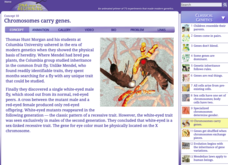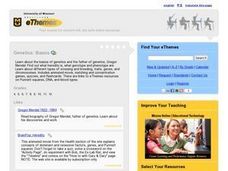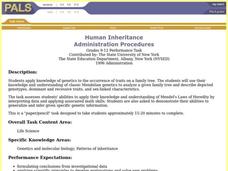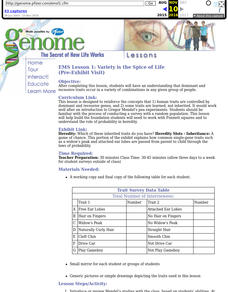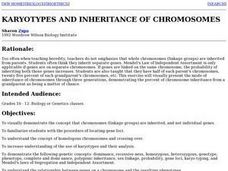US National Library of Medicine
Monster Genetics Lab
Harness young scientists' knowledge of genetics with an engaging science activity. Students start by flipping a coin to determine the genotypes and phenotypes of two parent monsters, before using Punnett squares to...
Curated OER
Parental Genes
Eighth graders explore how different organisms pass their traits to their offspring. In this life science lesson, 8th graders differentiate recessive and dominant alleles. They predict the phenotype based on the genotype of an organism.
Virginia Department of Education
Mendelian Genetics
How did Mendel know which pea plants would demonstrate certain characteristics? Pupils explore the answer this question, among others, as they complete Punnet squares, research dominant and recessive traits, and explore hereditary...
Curated OER
Cell Reproduction and Inheritance
Students determine their inherited characteristics from their parents. In this biology activity, students study the life of Mendel using an interactive website. They differentiate dominant and recessive characteristics.
North Carolina State University
Exploring Genetics Across the Middle School Science and Math Curricula
Where is a geneticist's favorite place to swim? A gene pool. Young geneticists complete hands-on activities, experiments, and real-world problem solving throughout the unit. With extra focus on dominant and recessive genes, Punnett...
Curated OER
Heredity: Your Connection To The Past
Students investigate genetics and the process of reproduction in living organisms.
Cold Spring Harbor Laboratory
Chromosomes Carry Genes
Some traits only exist in males and some only in females. Pupils learn how the location of genes on sex chromosomes determines them using an interactive lesson. An animation illustrates how scientists know this to be true and shows how...
Cold Spring Harbor Laboratory
Genetic Inheritance Follows Rules
Rules are not meant to be broken in genetics. Scholars learn to build Punnett squares to track the inheritance of dominant and recessive traits in an interactive animation activity. Online questions help individuals reflect on their...
Virginia Department of Education
Passing Traits to Offspring
What makes each one of us unique? Lead your class in this exciting and educational activity as you uncover traits that show how each individual is different from another. Pupils explore facts about DNA technology and predict the...
Cold Spring Harbor Laboratory
Genes Don't Blend
Yellow and blue make green—unless you're studying the inheritance of genetic traits. An interactive lesson explains the difference between blended traits and pure traits and gives examples of their occurrence. The resource includes a...
Curated OER
Basic Introduction to Foundation of Life: Genes, Genetics and Genetic Diseases
Learners are introduced to genetics along with genetic diseases and heredity. In groups, they complete a Punnett Square to determine the dominant and recessive genes. After viewing diagrams, they identify the characteristics of DNA and...
Curated OER
Genetics Challenge
In this genetics instructional activity, students fill in the blanks with terms related to genes, alleles, genotypes, phenotypes and heredity. They use their answers to complete a joke.
Curated OER
Genetics: Basics
Students study the basics of genetics and the father of genetics Gregor Mendel.
Curated OER
Genome's Greatest Hits
Pupils explore the progression of discoveries that have led to the genetics knowledge that scientists currently have. In groups, students research scientists that have made important contributions to understanding the molecules behind...
Curated OER
Traits
Sixth graders consider heredity. In this science lesson plan, 6th graders gain an understanding of certain physical traits are inherited from their parents through the genes.
Curated OER
Human Inheritance
Students analyze genetic characteristics in a given family tree through the F2 generation. Students apply prior knowledge from Gregor Mendel's study with pea plants and his Laws of Heredity to answer questions.
Curated OER
History of Biotechnology
Ancient, classical, and modern methods of biotechnological methods are introduced in this science PowerPoint. Students should be interested to see how advanced people have been through the ages in adapting their methods to procure...
Curated OER
The Hardy-Weinberg Equilibrium
Students act out a drama in this lesson on one aspect of the Hardy-Weinberg Equilibrium. They are to follow all stage directions precisely and give it their best effort to get across the main points of the play.
Curated OER
Where are the Dinosaurs?
Students construct their own diorama based on the life of a dinosaur. In this dinosaur lesson, students create models of dinosaurs and dinosaurs' eggs to explore the life cycle of this extinct species.
Curated OER
Bill Nye - Genetics
For this biology worksheet, students identify the different discoveries and genetics to complete 12 short answer questions related to the topic.
Curated OER
EMS Lesson 1: Variety is the Spice of Life
Students discern that dominant and recessive traits occur in a variety of combinations in any given group of people.
Curated OER
Karyotypes and Inheritance of Chromosomes
Students explore the mode of inheritance of chromosomes. Given a scenario, students use the Human Genome sheet to determine inherited chromosomes. They illustrate the difference between genotype and phenotype. Students develop a model...
Curated OER
Nature and Nurture
Students look into the role both nature and nurture play in determining an individual's traits. They examine how genes and the environment affect personality
Curated OER
Nature And Nurture
Learners develop an understanding of the role both nature and nurture play in determining an individual's traits. Using a website, students answer questions about nature and nurture in order to solve the riddle, What do you call a smart...








